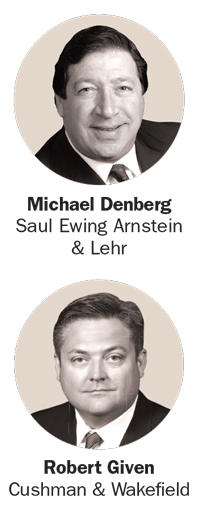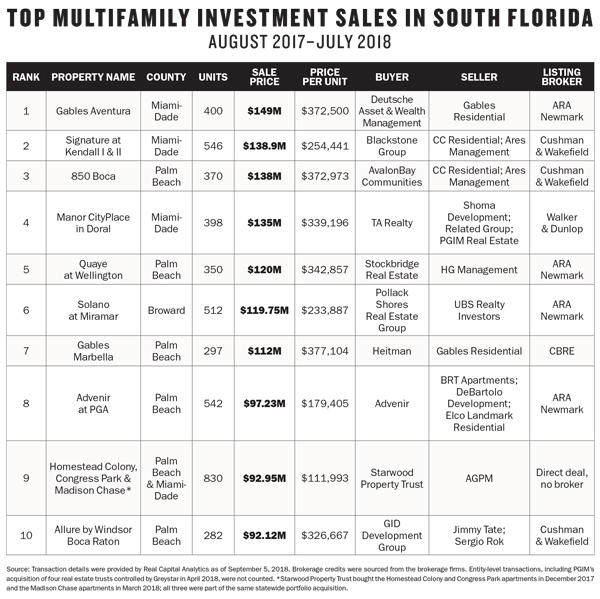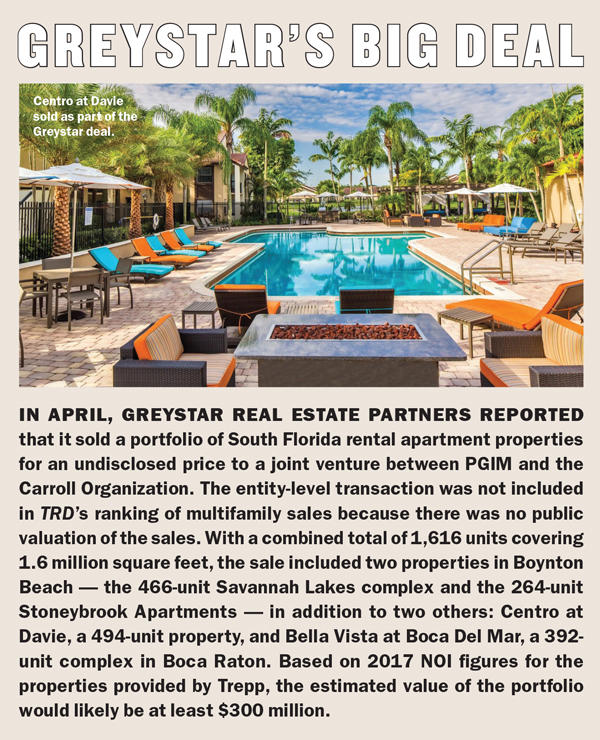Shortly after Robert Given and his Cushman & Wakefield team completed the December sale of the 370-unit apartment complex 850 Boca, the brokerage received a call from Sergio Rok and Jimmy Tate, the developers of a recently completed multifamily project nearby.
Like 850 Boca, the 282-unit Allure by Windsor was finished in 2017 and was located within Park at Broken Sound in Boca Raton, just west of the Interstate 95 Yamato Road exit. Both complexes are among the first rental projects to be developed in the 700-acre commercial park since city officials rezoned it for residential uses. “They had an interest in selling,” Given said. “And asked if any of the folks who had shown an interest in 850 Boca would consider Allure.”
It just so happened that GID, a national real estate investment firm based in Huntington Beach, California, was still in the market for a multifamily investment in Boca, Given told The Real Deal in a recent phone interview. “They wanted something in the immediate area,” Given said. “We were able to negotiate a direct deal between GID and Sergio and Jimmy.”

The sale closed in June with GID paying $92.12 million, or $326,667 per unit, which represented the 10th-priciest multifamily transaction in South Florida between Aug. 1, 2017, and July 31, 2018. In fact, more than half of the top 10 multifamily deals in TRD’s ranking occurred in Palm Beach County, where institutional investors are willing to pay a premium for new construction, brokers said.
AvalonBay’s $138 million purchase of 850 Boca was the third-priciest multifamily sale within the 12-month period tracked in the data TRD gathered from Real Capital Analytics. The company paid $372,973 a unit. AvalonBay’s takeover of 850 Boca represents the firm’s first deal in South Florida as the REIT expands beyond its usual markets on the east and west coasts, Given said.
Park at Broken Sound and the region that surrounds 850 Boca is a hotbed of high-income job growth that has good demographics and good schools, according to the broker, making it very attractive to young families who are also finding themselves priced out of other parts of the market. These dynamics are making institutional investors take notice. “It is fairly unique to own [a new multifamily project] west of 95,” Given said.
Across the tri-county region, institutional investors are seeking out properties in the western suburbs of Miami-Dade, Broward and Palm Beach based on millennial housing trends, Given said.
“Most of the buildings on the list have apartments ranging between 1,000 square feet to 1,200 square feet,” he said. “They are seeking strong school systems that are free and looking for a little more space than what they can afford in an urban corridor.”
Indeed, seven of the top 10 deals in TRD’s ranking were for apartment buildings located in suburban cities west of Interstate 95, the Florida Turnpike and the Palmetto Expressway. Over the next 12 to 36 months, Given said, he expects institutional investors’ appetite for suburban assets to continue based on millennials moving into these areas.
 Overall, interest from institutional investors in South Florida rental properties has remained steady. Compared to the same period last year, the total dollar value of the top 10 multifamily deals remained relatively unchanged at about $1.1 billion. However, the total number of units in the top ten that changed hands was higher this year (6,109) compared to the same period ending July 2017 (4,628).
Overall, interest from institutional investors in South Florida rental properties has remained steady. Compared to the same period last year, the total dollar value of the top 10 multifamily deals remained relatively unchanged at about $1.1 billion. However, the total number of units in the top ten that changed hands was higher this year (6,109) compared to the same period ending July 2017 (4,628).
“In the last 18 months there has been a strong appetite for core assets by institutions, insurance companies, foreign investors and private equity funds,” Given said. “We have seen groups moving into multifamily that have traditionally invested in retail and office. They have moved because of shrinking opportunities in those spaces.”
Three of the top five multifamily transactions occurred in Miami-Dade County. In August 2017, TA Realty picked up the 398-unit Manor CityPlace in Doral for $135 million. The Boston-based REIT, which typically focuses on office and industrial, paid $339,196 per apartment. The Related Group, Shoma Group and PGIM Real Estate Investors developed the luxury six-story apartment building as part of the CityPlace Doral mixed-use project.
Five months later, that transaction was trumped by the $138.9 million sale of the Signature at Kendall I and II. The buyer, Blackstone Real Estate Income Trust, paid $254,441 per apartment for the 546-unit project, which was developed by CC Residential and Ares Management. Topping the list is the June deal for Gables Aventura, a 400-unit mixed-use apartment complex at 19920 West Dixie Highway.
Gables Residential — a partnership between Clarion Partners, architect Isaac Sklar and Frontage Property Partners — sold Gables Aventura for $149 million to RREEF Property Trust, an arm of Deutsche Bank’s asset management unit. That breaks down to $372,500 for each apartment in the 16.3-acre development. Gables Residential’s Palm Beach project Gables Marbella also made the list at number seven. In May, the property was sold to Heitman for $112 million, or roughly $377,000 a unit.

Jay Jacobson, president of Coconut Grove-based development and real estate investment company Eden Multifamily, said institutional investors remain bullish about South Florida because the occupancy rate is holding strong. “There is still an enormous amount of capital looking for the safety of multifamily investment,” Jacobson said. “The market in South Florida remains pretty robust. The only negative is that rent growth has really slowed down.”
Today, rents are inching up at a 2 to 3 percent rate compared to a 6 to 8 percent growth five years ago, Jacobson said. But overall, “long-term migration and population growth are positive, which bodes well for the market,” he said. “There is plenty of equity out there to invest in properties.”
And the dollar value of the top 10 multifamily transactions shows that apartment developers are still in the driver’s seat, Jacobson added. “Some on the list are really nice products delivered by top-tier developers,” he said. “These guys got good pricing for them, and the institutions that bought them will do well.”
Michael Denberg, a partner with the law firm Saul Ewing Arnstein & Lehr, said market conditions are highly favorable for multifamily developers of new apartment projects. He is currently representing Tampa-based American Landmark as the company embarks on a $1.5 billion national buying binge, including its recent $56 million purchase of the 316-unit Park Colony Apartments in Hollywood with its partner RSE Capital.
“Prices have been moving up, and sellers are getting historically high prices,” Denberg said. “What I am seeing is that everybody wants to be near areas with job growth and good employment.”
Denberg noted that six of the top 10 multifamily deals from August 2017 through July 2018 show the buyers paid between $320,000 to $372,000 a unit. “If these were condos, regular people wouldn’t be able to buy them,” he said. “But at a rental level, you don’t need a huge down payment. You just need to have a stable job and a decent credit history. Institutional investors know they have a market. And they don’t have any money issues and can even close these deals with all cash in some cases.”
During a five-to-six-week period in the past year, his firm closed 11 multifamily transactions, Denberg said. “There are a lot of deals in the $50 million to $80 million range that have taken place,” he said. “Sellers are taking advantage by asking for hard deposits and shorter due diligence periods and closings.”
